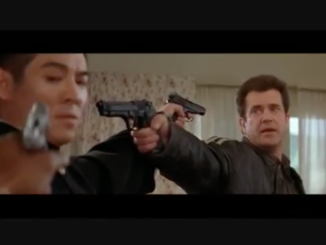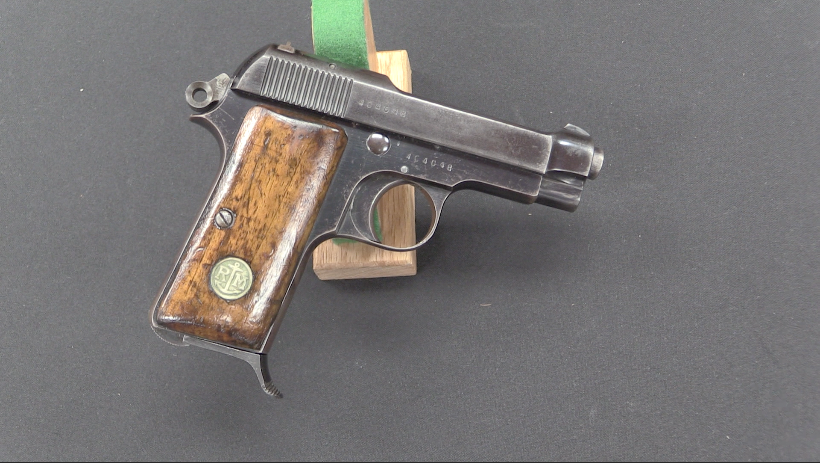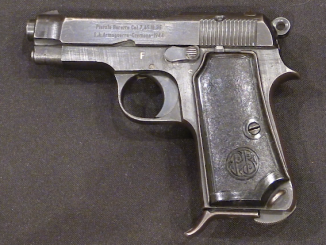Designed and manufactured by Fabbrica Nazionale d’Armi di Brescia (National Arms Factory of Brescia) in northern Italy, for use by the RSI and German military forces (as well as some partisan units). They were produced in 1943 and 1944, and only about 1,000 were made (all with serial numbers in the 5,000 range, for unknown reasons). They were quite expensive to produce, with milled receivers and a closed-bolt lever-delayed mechanism.
Interestingly, many of the surviving examples came out of Algeria, where a batch of the guns was smuggled in for use by independence forces. Their markings were milled off, and replaced by fake marks in an attempt to hide their origins – “Maschine Pistole P.M. 43” (an interesting combination of German and French elements). This example went back to France later, where it was unfortunately deactivated by the St Etienne proof house.
Many thanks to the Royal Museum of the Armed Forces and Military History in Brussels for access to this very rare piece! Check them out here:
https://www.klm-mra.be/D7t/




A fascinating gun, and why it was so expensively made is a mystery. I do like lever delayed guns, so it was good to see this one.
Why did it end up in Algeria? Maybe via Libya, which had been an Italian colony? I do like the attempt to hide its origins, but cannot think anyone was fooled for long. Still, plausible deniability and all that.
Although this gun is deactivated, it is a good job it is in a museum, because European Union laws have changed, and now it would be classed as “defectively deactivated”. To qualify as a deact in the EU now, it would basically have to be welded shut, which removes any interest a collector might have. The EU has succeeded in pretty well killing off the deact arms market. Well done, faceless bureaucrats!
“(…)Maybe via Libya, which had been an Italian colony?(…)”
Certainly not during Italian reign over Libya, considering that https://ww2db.com/country/Libya
(…)Feb 1943, Axis forces abandoned Libya(…)
and
Designed(…)for use by the RSI…
as Repubblica Sociale Italiana did not exist before Sep 1943.
Daweo:
The point I was making was that Italy still had influence in Libya, even after independence in 1951. It would be understandable that with their links, the Libyans may have procured Italian weapons.
What’s the point of hiding it’s origins? So France couldn’t get upset at the Italians if it was altered for the Algerians? Or ???
I am somewhat skeptical of the claim that the German markings were spoofed to conceal their origins. In fact, other FNA-B submachine guns turned up in Algeria around the same time, including their ultra-compact X5 SMG (which, as far as I know, never saw any other sales outside of this). The X5 was openly advertised as part of FNA-B’s product line at the time so it’s not like it was
More likely, in my opinion, the German markings were added for a Wehrmacht or Fallschirmjäger contract during WWII. The Germans were buying up lots of Italian SMGs towards the end of the war (the MAB 38/42 actually replaced the MP 40 as the standard Fallschirmjäger SMG). They were even buying TZ 45s. Seems perfectly reasonable to assume that these markings were just added for the German market.
As for how they reached Algeria? There are many possibilities but one major supplier of SMGs to the FLN was Georg Puchert, a Latvian arms dealer who apparently bribed gun manufacturers to have a large portion of their SMGs “fail” the QA tests and then officially go to the scrapheap. Unofficially they were being trafficked to North Africa. That’s how hundreds of Luxembourg-made SOLA submachine guns ended up in Algeria. Puchert was killed by a car bomb in 1959, no prizes for guessing who did that.
On an interesting note, the FNA-B submachine guns in Algeria seem to have been specifically issued to women’s units of the FLN.
These spurious German marking do not follow WWII practice.
Foreign weapons in German service were designated by a 2 or 3 digits number followed by a letter between brackets indicating county of origin.
Beretta 38/42 was MP 738(i) whole Beretta 38 was MP 739(i).
Those “foreign weapon” designations only existed on paper and were never actually marked on contract guns. 99% of these designations were utterly pointless and were never used.
I would not at all be surprised if FNA-B simply took it upon themselves to mark the German contract guns “Maschine-Pistole”.
If this was chambered for 9 mm Mauser Export, the lever-delayed design would make more sense, or at least it would to somebody familiar with Hungarian and Swiss designs. Or maybe there were vague plans to load Italian 9 x 19 mm even hotter?
“(…)all with serial numbers in the 5,000 range, for unknown reasons(…)”
https://guns.fandom.com/wiki/FNA-B_Model_43 states that
Serial numbers may have been artificially inflated to give the appearance of larger-scale production.
I would be hesitant to say this imply production number to be 1000 due to old adage which says absence of evidence is not evidence of absence.
Anyway if they were numbered sequentially and enough examples are known it is valid target for German tank problem https://en.wikipedia.org/wiki/German_tank_problem
Interestingly, despite low production number, imfdb
http://www.imfdb.org/wiki/FNA-B_43
show 16 Films in which said weapon was shown.
Buffer was also used in PPSh, see Рис. 12. Амортизатор затвора here
https://nastavleniya.ru/PPCH/ppch1.html
for 1940s example xor https://www.dmazay.ru/index.php?productID=11393 for current one (made from polyurethane)
Observe that one hole is present for keeping it in place, rather than few like in FNA-B 43 case.
Just bolt of this gun looks harder to make then some complete submachineguns.
Maybe they did it on purpose, to make smallest amount of guns yet present that factory is doing something, hard as hell. Because that could be a plausible story after war how they by design sabotaged axis war effort…
There is yesterdays posted shooting video, ROF is around 800 rpm !
I’m going to question the basic premise about the markings and deletions of markings on this weapon.
The first thing I’m going to point out that those fire control markings were done on a milling machine, something that’s really unusual in terms of the usual run of things done with these sorts of weapons. Someone went to the trouble of setting up a mill to efface those marks, and you normally only do that when you a.) have access to a mill and a semi-professional work force, b.) want to utterly obliterate the markings, and c.) have an objective point in doing so.
In this case, one really has to wonder: Who had enough of these things on hand that they thought it necessary to hide where they came from, and who also had the time, equipment, and manpower to do it? Also, the motivation? What would the point have been? It’s not like the weapon design in and of itself wasn’t distinctive enough to make all that crystalline-clear, so… Why’d they bother?
Makes about as much sense as “sanitizing” something like a Lahti pistol; you know where all of those came from, either Finland or Sweden. It’s not like you’re going to obscure the source or the provenance, either. Best you could hope for was maybe being able to hide some production details by defacing the serial number, but… Why bother?
Someone went to a lot of trouble to get rid of those markings, and I would be willing to bet that knowing who/why it was done would illuminate a lot of things. I honestly don’t see the sense of it, at all. Not unless all of these weapons were held somewhere in one place, after the war, and the guys supplying the Algerians had to hide that at all costs, which doesn’t make a lot of sense given the multitude of forces feeding into Algeria during that time frame.
The whole issue really doesn’t make a lot of sense at all, from where I’m sitting in 2022. Maybe in the immediate post-WWII era it all made sense to someone, but I’ll be damned if I can follow their reasoning.
That place can be FNAB factory.
Let’s say there is a batch of weapons that had been manufactured in the last months of the war, but never delivered to the RSI army.
In that case, the weapons, ordered and paid by the RSI, would be property of the new Italian Army, but they are not really searching for them. The Italian Army is standardising it’s equipment they don’t know what to do with a myriad of different SMG models.
But, had FNAB tried to sell them, surely the government would have recalled those weapons were his property, and so FNAB couldn’t sell them.
So, you came up with some fake German marking before selling them to some arms dealer and, if someone find out there are FNAB-43 used by the Algerian FLN, those are weapons seized by the Germans during the war, or directly ordered by them, that ended up in Algeria in some way (yeah, that was not the way the Germans really marked the weapons they seized, but who cares? It was not like in Brescia there was literature on German markings).
This is a plausible story!
@Kirk “Makes about as much sense as “sanitizing” something like a Lahti pistol; you know where all of those came from, either Finland or Sweden”
You know, with your 2022. FW videos knowledge.
60 years ago in Algeria being a peasant there, you know nothing about history of firearms, possibly you are even illiterate in latin script and can’t even read the fake markings. And if you do read them, you could easily believe its german, why not? Same goes for any local government superiors, they are not gun research nuts.
There are/were some regions where “Schmeisser” is a generic term for ANY submachinegun…
You take 300-plus words to say, “Darned if I know!”